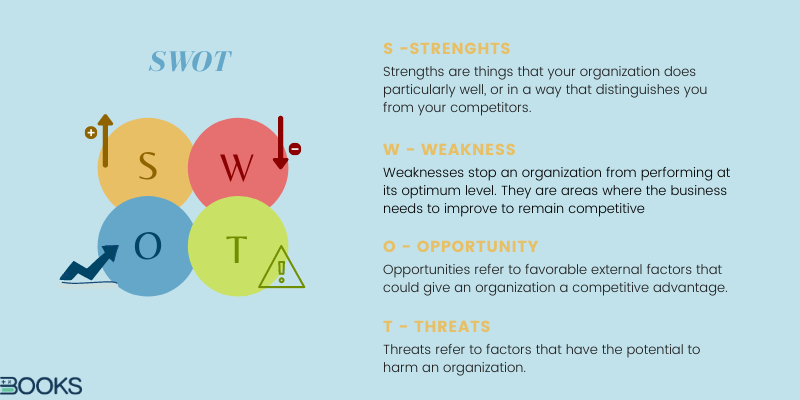01 Feb

Running a business yet can’t decide what are its challenges and chances that we can overcome or take advantage of? Or thinking of starting your own business but not able to look at any pro advice?
Today, I’m here to tell you how you can grow your business, with proper planning and analyzing. Also, I will share some essential tips for young entrepreneurs who are preparing to make their own business.
To run a business successfully, you require not only proper planning but also you should regularly analyze your processes to ensure that you are operating as efficiently as possible.
There are many ways you can analyze your company. However, one of the most effective method is to conduct a SWOT analysis.
Now, what is SWOT? And how you can analyze your company using this method? Well, it’s simple and interesting as well!
SWOT is an acronym for 4 major key-concepts for a successful business.
- S = Strength
- W = Weakness
- O = Opportunity
- T = Threats
Moving forward, let’s look at its brief meaning!
Understanding SWOT Analysis
A SWOT analysis is a compilation of your company’s strengths, weaknesses, opportunities and threats. It is a planning process that helps your company overcome challenges and determine what new leads to pursue.
Strengths
Strengths are the rare qualities our company has that make us to keep moving towards the organization’s goal. The strengths depict the basics on which the company can continue to be powerful in the market and achieve success. We can sustain and continue the success on the pathway made by strengths.
Further, strengths can be tangible as well as intangible. These comprise what you are well-acquainted with or what you have proficiency in, the qualities and excellences your members have (individually or as a unit) and the distinctive factors that provide your company its consistency in the market.
In simple words, the favorable conditions of the company or the abilities of an organization is what we consider as strength in SWOT analysis. These include human aptitudes, work skills and efficiencies, economic reserves, brands and services, vast product distribution network, debt-free, hard-working and efficient employees, etc.
Weakness
Weakness are the flaws in the company’s structure, operations, or employees that create hurdles in the way to success. Such traits pull the company back to accomplish the organizational goals and restricts its full potential. These weaknesses exploit the company’s growth. They mostly comprise the influences that don’t level up to the standard as we think they should.
Some examples of weaknesses in a company are depreciating machinery, poor research and development resources, low product range, lack of rightful decision, etc. However, we can control weaknesses. The company should minimize and gradually eliminate their weakening points. Let’s say, you have an obsolete machinery as a weakening trait. You should overcome it by purchasing a new machinery.
Weaknesses are the qualities that prevent us from accomplishing our mission and achieving our full potential. These weaknesses deteriorate influences on the organizational success and growth. Weaknesses are the factors which do not meet the standards we feel they should meet. Other precedents of organizational weaknesses are enormous debts, excessive employee turnover, sophisticated decision-making process, limited product range, considerable misuse of raw materials, etc.
Opportunities
Opportunities are the favorable traits that a company can use to gain a competitive advantage. Its forms by the environment surrounding the company. These opportunities occur when the company can earn favor of conditions in its surrounding to form and implement policies that empower it to grow into more productive.
Company should be cautious to note the opportunities and perceive them whenever they crop up. Choosing the objects that are worth benefit the clients while bringing effective results is an arduous task. Opportunities may result from market rivalry, commerce/politics, and technology. Growing use for telecommunications followed by free trade is an exceptional opportunity for modern companies to introduce telecom sector and contend with prevailing enterprises for gain.
Threats
Threats emerge when situations in external environment threaten the security and profitability of the company’s business. They add to the vulnerability for a company’s growth when they refer to the weaknesses. Unlike weakness, threats are uncontrollable. When a peril comes, the strength and vitality can be at risk. Examples of threats are – discord among laborers; frequently changing technology; increasing struggle to lead extreme efficiency, price wars, and undermining industry gains; etc.
The primary aim of a SWOT analysis is to help organizations develop a full awareness of all the factors involved in making a business decision.
While performing a SWOT analysis, you’ll be proud like… “Ok…. So, they all are my strengths!”, But at the very next moment you’ll be like… “I have these threats too! Oh no!!”

Ok, it went too dramatic; I know.
But yes!
Perform a SWOT analysis before you commit to any sort of company action, whether you are exploring new ideas, revamping internal policies, considering opportunities to pivot or altering a plan midway through its execution.
Use your SWOT analysis to discover recommendations and strategies, with a focus on leveraging strengths and opportunities to overcome weaknesses and threats.
Aim of SWOT Analysis
The primary aim of a SWOT analysis is to help organizations develop a full awareness of all the factors involved in making a business decision. This method was created in the 1960s by Albert Humphrey of the Stanford Research Institute, during a study conducted to identify why corporate planning consistently failed. Since its creation, SWOT has become one of the most useful tools for business owners to start and grow their companies.
The purpose of SWOT analysis is to elicit the think pool of the company developing impact of the progress for a specific issue. When a business is fruitless to look at a crucial strength, weakness, threat, or opportunity, are possible to bring out shoddy business decisions.
“It is impossible to accurately map out a small business’s future without first testing it from all angles, which includes an exhaustive look at all internal and external resources and threats,” Bronnie Taylor, chief marketing strategist at CCS Innovations, told Business News Daily. “A SWOT accomplishes this in four straightforward steps that even rookie business owners can understand and embrace.”
When should you perform a SWOT analysis?
You can employ a SWOT analysis before you commit to any sort of company action, whether you are exploring new initiatives, revamping internal policies, considering opportunities to pivot or altering a plan midway through its execution. Sometimes it’s wise to perform a general SWOT analysis just to check on the current landscape of your business so you can improve business operations as needed. The analysis can show you the key areas where your organization is performing optimally, and which operations need change.
Don’t make the mistake of thinking about your business operations informally, hoping they will all come together cohesively. By taking the time to put together a formal SWOT analysis, you can see the entire picture of your business. From there, you can discover ways to improve or eliminate your company’s weaknesses and capitalize on its strengths.
While the business owner should certainly be involved in creating a SWOT analysis, it is often helpful to include other team members in the process. Ask for input from a variety of team members and openly discuss any contributions made. The collective knowledge of the team will allow you to adequately analyze your business from all sides.
Characteristics of a SWOT analysis
A SWOT analysis focuses on the four elements of the acronym, allowing companies to identify the forces influencing a strategy, action or initiative. Knowing these positive and negative elements can help companies more effectively communicate what parts of a plan need to be recognized.
When drafting a SWOT analysis, individuals typically create a table split into four columns to list each affecting element side by side for comparison. Strengths and weaknesses won’t typically match listed opportunities and threats verbatim, although they should correlate, since they are ultimately tied together.
Billy Bauer, managing director of Royce Leather, noted that pairing external threats with internal weaknesses can highlight the most serious issues a company faces.
“Once you’ve identified your risks, you can then decide whether it is most appropriate to eliminate the internal weakness by assigning company resources to fix the problems, or to reduce the external threat by abandoning the threatened area of business and meeting it after strengthening your business,” said Bauer.
Internal factors
In SWOT analysis, Strengths (S) and weaknesses (W) refer to internal factors, which are the resources and experience readily available to you.
These are some commonly considered internal factors:
- Financial resources (funding, sources of income, and investment opportunities)
- Physical resources (location, facilities and equipment)
- Human resources (employees, volunteers and target audiences)
- Access to natural resources, trademarks, patents, and copyrights
- Current processes (employee programs, department hierarchies, and software systems)
External factors
External forces influence and affect every company, organization and individual. Whether we connect directly these factors or indirectly to an opportunity (O) or threat (T), it is important to note and document each one.
External factors are typically things you or your company do not control, such as the following:
- Market trends (new products, technology advancements and shifts in audience needs)
- Economic trends (local, national and international financial trends)
- Funding (donations, legislature, and other sources)
- Demographics
- Relationships with suppliers and partners
- Political, environmental and economic regulations
After you create your SWOT framework and fill out your SWOT analysis, you will need to come up with some recommendations and strategies based on the results. Linda Pophal, owner and CEO of consulting firm Strategic Communications, said these strategies should focus on leveraging strengths and opportunities to overcome weaknesses and threats.
“This is actually the area of strategy development where organizations have an opportunity to be most creative and where innovative ideas can emerge, but only if the analysis has been appropriately prepared in the first place,” said Pophal.
Example of SWOT Analysis
In 2015, The Coca-Cola SWOT analysis by Value Line brought out its strengths, including its wide distribution networks, its globally famous brand name, and opportunities in growing market. However, the swot analysis also wrote down its weakness, such as foreign currency fluctuations, emerging public preferences for healthy beverages, and competition from companies producing healthy beverages.
This SWOT Analysis of The Coca-Cola Company made the analysts to bring some really tough question about Cola-Cola’s strategy, yet also to keep in mind that the company might be a first-tier beverage produced that offers its investors a trusted source of income and some amount of capital profits as well.
During the first five years, the SWOT analysis by Value Line proved right as Cola-Cola is the 6th biggest and powerful brand across the globe (as it was before). Cola-Cola’s number of shares has consequently increased by about 60% during the five years after the SWOT analysis was made.
Other essential tips for young entrepreneurs:
Every young entrepreneur needs a personal Business Guru but if you’re struggling alone, then this is for you. Or you can also read the primary keys to start a small business of your own.

Hello entrepreneurs out there! I’m your business Guru.
Here, you will come across some essential tips that every young entrepreneur should know.
Entrepreneurship is such a field where one can sense freedom and empowerment. You can build your empire and watch them grow and expand. It’s a great way to live a successful life.
That’s why I’m here to give you some 17 major tips which would help you grow.
1. Believe in yourself.
For starting a new business, a young entrepreneur should believe in oneself that yes, he can do that. As Henry Ford famously said, “Whether you think you can, or think you can’t, you’re right.” Have believe in yourself and you can succeed and can find your way through obstacles. If you don’t, you can never succeed.
2. Face your fears.
You must learn to tame your fear. Try to get the better of your fears to achieve your goal. Getting over your fear isn’t easy, but it’s mandatory to be done. As Arianna Huffington once said that for her fearlessness was like a muscle; the more she worked out on it, the sturdier it became.
3. Get gritty.
Grit is the courage and strength of a character. Every entrepreneur should possess the go-get-them attitude. This depicts the strength and attitude of the entrepreneur towards its business and goals. Grit is the courage to keep working, even though everyone says to give up. You must be gritty if you want to succeed in this entrepreneurial world.
4. Be passionate.
Do what you love to do. If you don’t love what you do, just leave it aside. It’s the real strategy behind every successful entrepreneur in this world to follow your passion.
In entrepreneurship, you have to give in long hours and make sacrifices. When you’re passionate about what you do, it won’t feel like sacrifice anymore. You will feel like investing your time and hard work to your business.
Following your passion will motivate you to be persistent in your entrepreneurial world.
Have you ever noticed any entrepreneur who never gets tired or stressed about their work and has a gleam in their eyes towards what they do?

I can do it! In fact, I will do it!
Yes, that’s passion!
5. Take risk.
Being an entrepreneur, one must not be a risk-averse person. For successful entrepreneurs, taking risk is like a part of a job for them.
Risk – taking can be dangerous too, but often the opportunities they give outweigh the danger. Successful entrepreneurs know which risk is worth taking and which isn’t? Never stop for any risk thinking it may harm. Analyze it with your strengths and overcome with success.
You will have to practice and learn to identify which risk will benefit your business, and you’ll be a step ahead in being a successful entrepreneur. You can use the SWOT analysis to effectively go through your weaknesses, strengths, threats, and opportunities.
6. Challenge yourself.
In this entrepreneurial world, no one is going to push you all along. Only you’ll be there standing alone in the chaos of challenges, so you must challenge yourself if you want to succeed in your business.
You must always look for the next challenge, and you’ll always be prepared to face what comes your way. If you are ready to face challenges, you can turn that into a splendid opportunity also, but it’s only possible if you are prepared to look up for more.
One of the famous entrepreneurs, Richard Branson, states that his biggest motivation is to keep challenging himself. He often treats life like a long-term university education, where we learn something every new day.
7. Have a clear vision.
Vision is the ability to think and plan about the future with mind and wisdom. An entrepreneur must be clear about what he desires to create. Without a clear vision, there’s no way to survive for a long term.
So, keep your vision clear and determined all times.
8. Act on your thoughts.
The world is full of captivating ideas, but success only knocks those entrepreneurs’ door who take action.
The famous Walt Disney noted that the easiest way to get started as an entrepreneur is to quit talking and start taking actions. Talk only delays actions and delaying sometimes results in losing opportunity to the more upcoming entrepreneurs.
Don’t delay your decisions. Act on your thoughts at full tilt with wisdom.
9. Find good people.
The people who surround you affect the most on how you work. So, work with good people who are positive, motivated and determined towards their goals.
10. Invest time.
Everyone was once a beginner; success doesn’t come immediately. You need to invest your time and hard work to start and grow your business successfully. Steve Jobs wisely said, “If you look closely, most overnight successes took a long time.”
So, don’t be afraid to invest more time in your company.
11. Build a cooperative team.
Every entrepreneur needs a great team to bolster their success. No one succeeds in business without a good cooperative team, and if one tries to do so, he will automatically lose it to a great team every time. Success won’t come within a vacuum; we all need a great support network behind us.
So try to build your own team.
12. Hire partners with character.
Now, this is the most important part for building up a great team. A team can do great things together that one alone might not. However, to achieve great heights with a team, unity is important.
Have you seen minions? Unity is what they explained!

We can do it together!
As you build your team, hire partners with character that you would respect.
When I recommend hiring brilliant partners, I don’t just mean for the one who can work for you, but the one whom you would like and respect and who has a prominent character.
If you are with people with the character you don’t respect, your team won’t last for long. Hiring partners with moral character in your team will make your way to success.
13. Finance planning.
Start-ups for an entrepreneurial business, money is obligatory. To start a business, the emerging entrepreneur needs to plan for its capital. It’s just a part of the business cycle.
Many entrepreneurs use their own savings to start their business, but that’s too risky. You should always plan for your funds and minimize your risk.
Richard Harroch, Managing Director and Global Head of M&A for VantagePoint Capital Partners, a large venture capital fund in the San Francisco area, wisely advises the upcoming entrepreneurs: “It’s almost always harder to raise capital than you thought it would be, and it always takes longer so plan for that.”
14. Spend wisely.
When you use your capital, just don’t forget to use it wisely. Don’t foolishly spend all your money in excitement and run out of capital too soon.
Spend where it’s obligatory to do so or where you can see more productive options.
15. Who’s your customer?
Before you start your business, make sure there are customers in the economy who will buy that product or services which you’re planning to produce.
Most of the entrepreneurial businesses fail due to lack of customers. So it’s very important to know your customers first.
Without customers, there can’t be a standing enterprise. So know your customers before taking any further step.
16. Learn from complaints.
This is one of the most important tips which an entrepreneur must learn.
When you receive any complain from your customer, don’t just ignore it. Customer complaint is a significant source to identify your business’ weakness. Try to learn from those complaints and improve your services for better reviews next time.
Bill Gates once noted that your most unhappy customers are the greatest source of learning for you.
By taking your customer’s complaints seriously, you can learn where the snag in your services is. This will also increase customer’s trust towards your enterprise.
17. Deliver more than expected.
I’d recommend this one as a bonus tip for all emerging entrepreneurs.
Always try to deliver more than your customers expect what. By exceeding expectations, it will have satisfied customers, investors and business partners.
Promising and not delivering is a good way to lose your customers’ faith in your company, but delivering more than what you promised would create brand loyalty.
In short, successful entrepreneurs exceeds expectations.
18. Use a POS system for your business.
A POS Software is what a brick and mortar retail outlets need to execute sales. It is basically a software that allows a face-to-face faster customer checkout services. A sales through a POS Software takes place in a time between the merchant and the customer.
Using a POS Software, a merchant can avail several benefits. Such advantages include inventory management tools, CRM and promotional offers, accounting and book-keeping, staff management. Further, you can also check your daily sales report and so on.
Summary –
I hope this post may have helped. If you follow these 17 essential tips, it will help you in your long-term journey in the entrepreneurial world.
Starting a business of your own is not an overnight task, for this you will have to invest your blood and sweat by following these simple strategies with baby steps until it comes to success.
To all the young entrepreneurs out there, just remember that hard work always pays and pays even better when done with wisdom. After your business takes a plunge, start analyzing your company using SWOT analysis method discussed above. Proper planning and strategizing directs your business on a right pathway, improving its growth in the market.
Always try to reduce your weakness and keep up with your strengths. Let us know if you can suggest any other business tips or methods or drop any queries in the comment section below.








